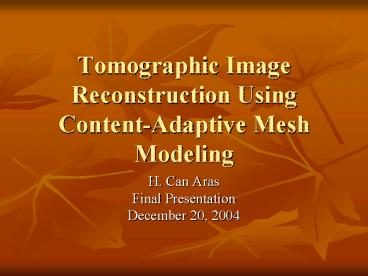Tomographic Image Reconstruction Using ContentAdaptive Mesh Modeling - PowerPoint PPT Presentation
1 / 30
Title:
Tomographic Image Reconstruction Using ContentAdaptive Mesh Modeling
Description:
Tomographic Image Reconstruction Using Content-Adaptive Mesh Modeling. H. Can Aras ... What has been done before the second presentation? ... – PowerPoint PPT presentation
Number of Views:73
Avg rating:3.0/5.0
Title: Tomographic Image Reconstruction Using ContentAdaptive Mesh Modeling
1
Tomographic Image Reconstruction Using
Content-Adaptive Mesh Modeling
- H. Can Aras
- Final Presentation
- December 20, 2004
2
Overview
- What is the problem?
- What has been done before the second
presentation? - What has been done after the second presentation?
- Enhancements
- Alternative Approaches
- Conclusion
3
CT-Imaging
- A special radiographic technique that uses a
computer to assimilate multiple X-ray images into
a 2D cross-sectional image - Important for viewing the human body and
diagnostic purposes. - Quality of CT-Images is important.
4
The Procedure
- The CT machine rotates 180 degrees around the
patients body, sending out an X-ray beam. - Sensors positioned at the opposite points of the
beam record the absorption rates of the varying
thicknesses of tissue and bone. - These data are then relayed to a computer that
turns the information into a picture (CT-Image)
on a screen.
5
Projection Data
SinogramAll projections
ProjectionAll ray-sums in a direction
?
y
P(??t)
t
p
?
x
f(x,y)
t
X-rays
Sinogram
6
Problem Aim
- Reconstruction of CT-Images from Projection Data
- There are many algorithms for reconstruction
(ART, FBP) - FBP is the most well-known, but not perfect
especially in case of noisy or incomplete data. - The aim is to get a better reconstruction of the
CT image by using a mesh model instead of the
traditional pixel-based models.
7
Overview
- What is the problem?
- What has been done before the second
presentation? - What has been done after the second presentation?
- Enhancements
- Alternative Approaches
- Conclusion
8
Approach
- Content-Adaptive Mesh Generation
- Feature Map Extraction (Second derivative)
- Placement of Mesh Nodes (Floyd-Steinberg)
- Connecting Mesh Nodes (Delaunay)
- Estimation of Mesh Nodal Values
- MESH-EM algorithm
- Reconstruction of the Image
- Approximation over each mesh element (triangle)
9
Result
10
Result (cont.)
- It is difficult to judge which result looks
better. A physician can tell you. - Even different physicians can tell you different
things. - SNR can be used.
- Other validation techniques can be used, e.g.
cardiac perfusion detection. This is out of the
scope of this project.
11
Overview
- What is the problem?
- What has been done before the second
presentation? - What has been done after the second presentation?
- Enhancements
- Alternative Approaches
- Conclusion
12
Better Filter used for FBP (? 5)
13
More Projections (? 2)
14
Less Projections (? 10)
15
With Smoothing (? 10)
16
More Iterations (? 10)
17
Synthetic (? 10)
18
Brain (? 10)
19
Spine (? 10)
20
Overview
- What is the problem?
- What has been done before the second
presentation? - What has been done after the second presentation?
- Enhancements
- Alternative Approaches
- Conclusion
21
Approach
- Content-Adaptive Mesh Generation
- Feature Map Extraction
- Placement of Mesh Nodes
- Connecting Mesh Nodes
- Estimation of Mesh Nodal Values
- MESH-EM algorithm
- Reconstruction of the Image
- Approximation over each mesh element
22
Barycentric Coordinates
- Why not use Barycentric Coordinates instead of
using a Master Element? - They are doing the same thing
23
Approach
- Content-Adaptive Mesh Generation
- Feature Map Extraction
- Placement of Mesh Nodes
- Connecting Mesh Nodes
- Estimation of Mesh Nodal Values
- MESH-EM algorithm
- Reconstruction of the Image
- Approximation over each mesh element
24
Using Gradient Image (? 5)
25
Comparison (? 5)
26
Using Watershed Segmentation-I (? 5)
27
Using Watershed Segmentation-II (? 5)
28
Using Watershed Segmentation-III (? 5)
29
Overview
- What is the problem?
- What has been done before the second
presentation? - What has been done after the second presentation?
- Enhancements
- Alternative Approaches
- Conclusion
30
Thank you
- Questions?































